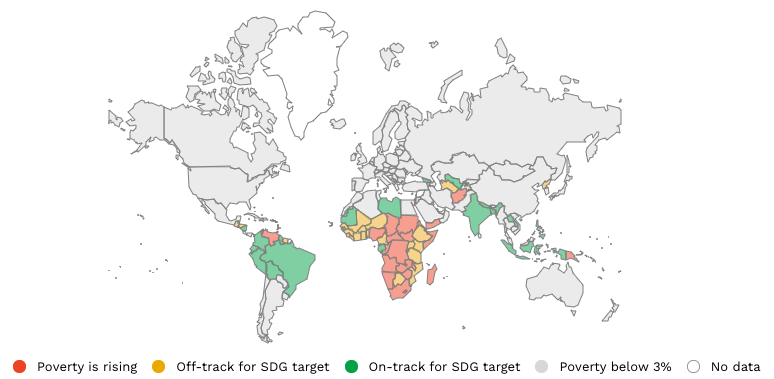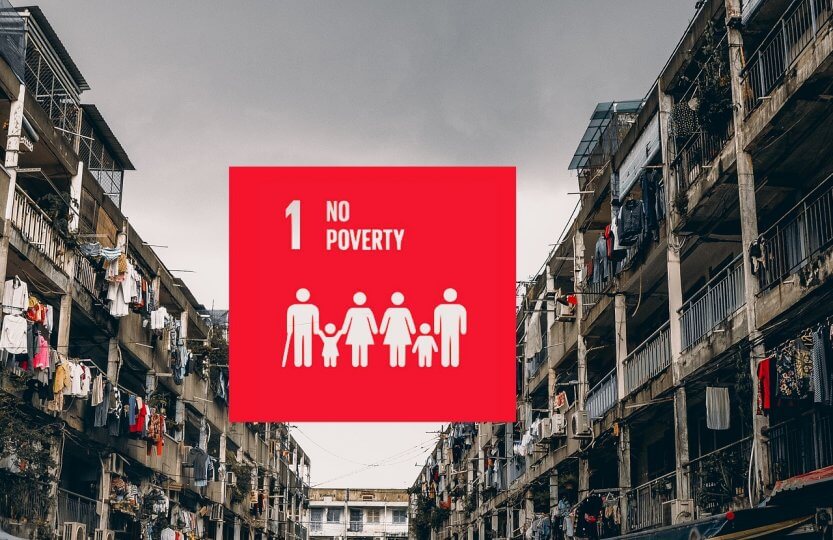Poverty eradication has always been at the core front of the United Nations. In the year 2000, in the Millenium Declaration, 189 countries agreed to devote themselves to “spare no effort to free our fellow men, women and children from the abject and dehumanizing conditions of extreme poverty”. By setting the “International Poverty Line”, the World Bank defined extreme poverty as a state when an individual is living on less than 1.90 international dollars per day. Poverty, however, is not only measured by one’s wealth, but also by a set of different dimensions. As the world struggles to progress and achieve the SDGs, the current scenario becomes more challenging for the 2030 Agenda for Sustainable Development with climate change and the covid-19 pandemic.
Revisiting the concept of sustainability, which implies that EVERYONE’s needs should be met, makes one understand why in 2002 in the Johannesburg Plan of Implementation the first SDG was described as “the greatest global challenge and an indispensable requirement for sustainable development”. For universal sustainability, the well-being of humans, biodiversity and the planet as a whole should be ensured. Figure 1 below presents the progress that has been accomplished in regards to people living in extreme poverty. From year 1981 to 2015, there is a decline from 42.12% to 9.94% in the number of individuals living on less than $1.90 per day. At this very moment, there are still 8.4% of world’s population living in such conditions (UN, 2020), a percentage that accounts for over 700 million people.

Source: WorldBank, PovcalNet2019
Poverty is a complex problem that is influenced by different elements, and when taking all these other aspects into account – besides the “International Poverty Line” threshold – the situation can even worsen. According to the United Nations Human Development report on “The 2020 Global Multidimensional Poverty Index (MPI)”, currently, in 107 developing countries, 22% of their inhabitants live in multidimensional poverty. This means that there are 1.3 billion people in the world who are deprived from any of those three important life dimensions: health, education or standard living. The MPI is calculated based on a set of 10 indicators framed within the three aforementioned dimensions (You can check the table here). It emerges as a useful tool to monitor poverty and the progress for the achievement of the SDG1.
Another interesting tool to track the progress towards the “end of poverty in all of its forms everywhere” is the World Poverty Clock. The World Poverty Clock comprises a peer-review model with a dataset updated by November of 2020, that already considers the effects of the covid-19 pandemic on poverty. One of the highlights of this model is the free access to the tool on the website aforementioned. Anyone can do their own analysis, verify through graphs or maps which countries are on-track or off-track to meet the SDG1 by 2030 (Figure 2) and what are the numbers of individuals in poverty every year. It is also possible to make a comparison about the reality of each country, filter by gender and age, and soon there will be a geographical filter (rural and urban).

Source: World Poverty Clock, 2021
In 2030, the year when the SDGs are supposed to be met, the model presents that there will be still 565 million people living in extreme poverty. Sadly, this result is not so surprising. Prior to 2020, many countries were already off-track to achieve the SDG1 by 2030. However, the covid-19 pandemic has intensified the scarcities and hardships faced by millions across the world and has made it harder for people to try to escape poverty. As it is shown on Figure 3, after the pandemic millions of people were pushed back to poverty. More specifically, the UN statistical report (2020) estimates that the covid-19 pandemic will lead 71 million people into extreme poverty. Furthermore, covid-19 joins other ailments that often affect humans living in vulnerability, such as malaria, diarrhea and pneumonia. These are in some cases preventable, stemming from malnutrition, contaminated water and lack of hygiene and sanitation. According to the 2017 Unicef report on Child Mortality, one in thirty-six children dies in the first month due to preventable diseases in least developed countries. As we all know by now, washing our hands has a significant positive impact in our health; still, not everyone has access to clean water in this world, nor live in appropriate conditions.

Source: United Nations, Statistics Division, 2020, Goal 1
Being in a place of vulnerability, individuals living in poverty are marginalized within the society and end up building their households in locations that are unsafe, making them more exposed to natural hazards. As climate change drives up the frequency of extreme events, droughts, floods, hurricanes and wildfires, it threatens people’s lives, their housing, and economic support. In developing countries, many marginalized communities live in unsteady structures, and rely on agriculture for their income and also for subsistence. It has been reported an economic loss measured up to $23.6 billions due to natural disasters; from those, 73% were in the agricultural sector and 16% in the housing sector (UN Stats, 2020). Climate change affects all social and economic sectors that structure this world’s way of living.
To end poverty in all of its forms everywhere is one goal, but it is not only related to one’s income or consumption power. Poverty is a humans’ rights issue, a health, an educational, and a climate matter. When one SDG is improved, several others are as well. It is a chain reaction! Interconnectivity is the key word to bring solution. More union between the nations, better governance and political willingness to aid and support local communities and vulnerable individuals is necessary. Enhancing economic growth in the least developing countries should be a target, as well as increasing accessibility to education, health and sanitation. As climate change and the pandemic aggravate the scenario for poverty, we should stand as one world and one people to turn these issues around, to help improve the current situation and mitigate damages. There are 17 SDGs, poverty eradication is the first – but there really is only one objective, and that is a better world to everyone from all the nations.
References:
Cuaresma, J.P. et al. (2018) – “Will the Sustainable Development Goals be fulfilled? Assessing present and future global poverty”. OpenAccess.
Max Roser and Esteban Ortiz-Ospina (2013) – “Global Extreme Poverty”. Published online at OurWorldInData.org. Retrieved from: ‘https://ourworldindata.org/extreme-poverty’
Reports:
Progress towards the Sustainable Development Goals, Report of the Secretary-General










nice topic thank you
nice topic